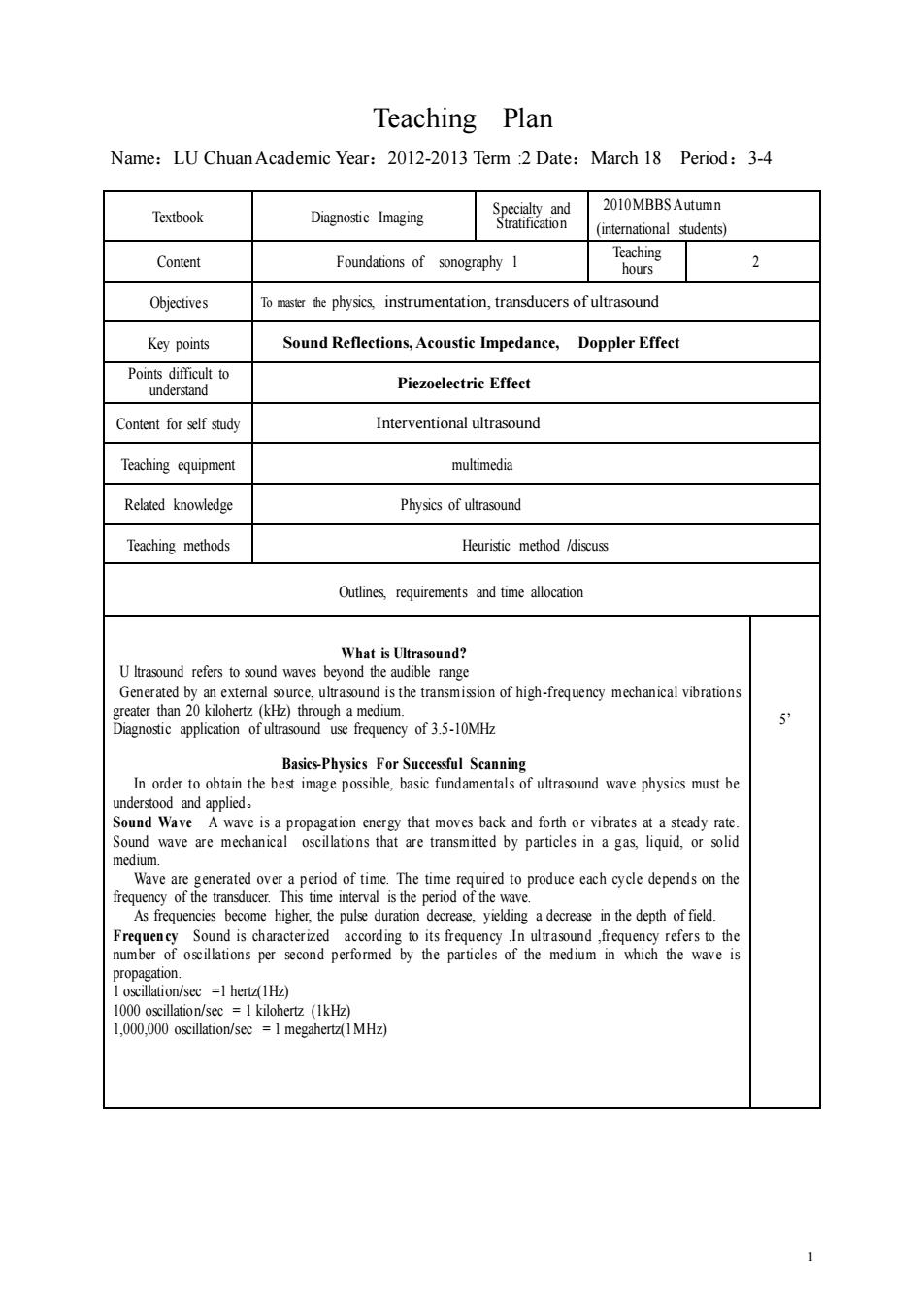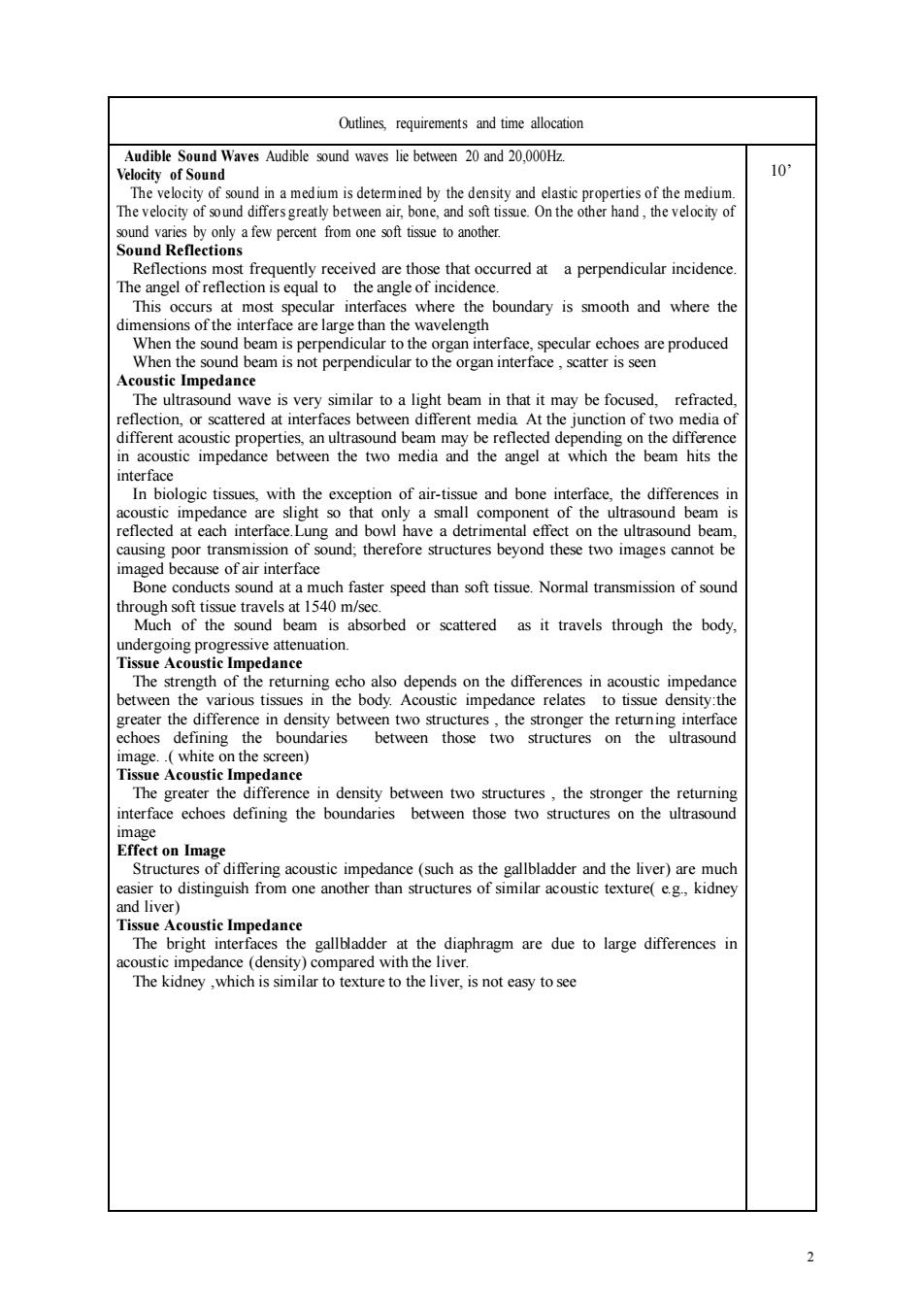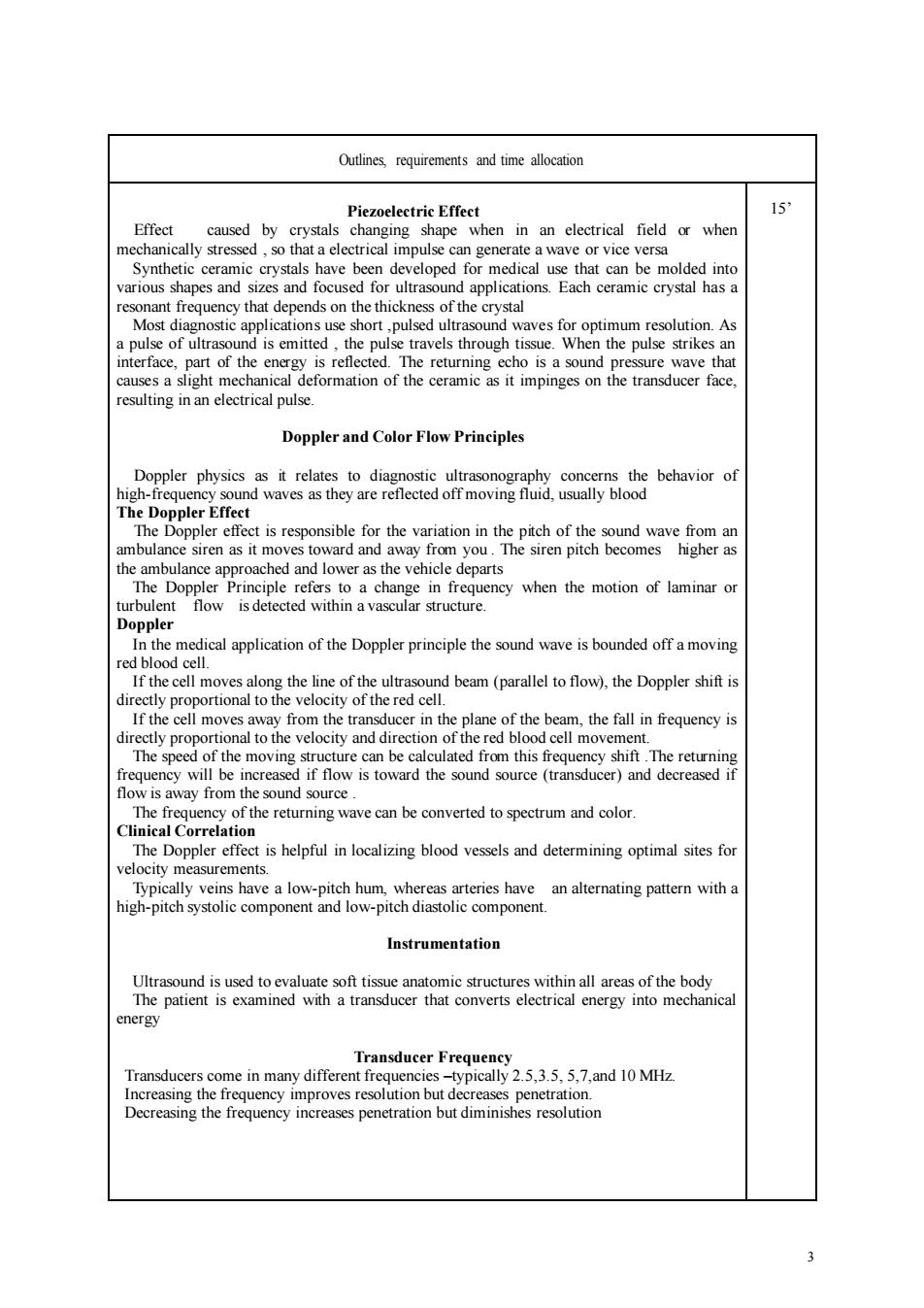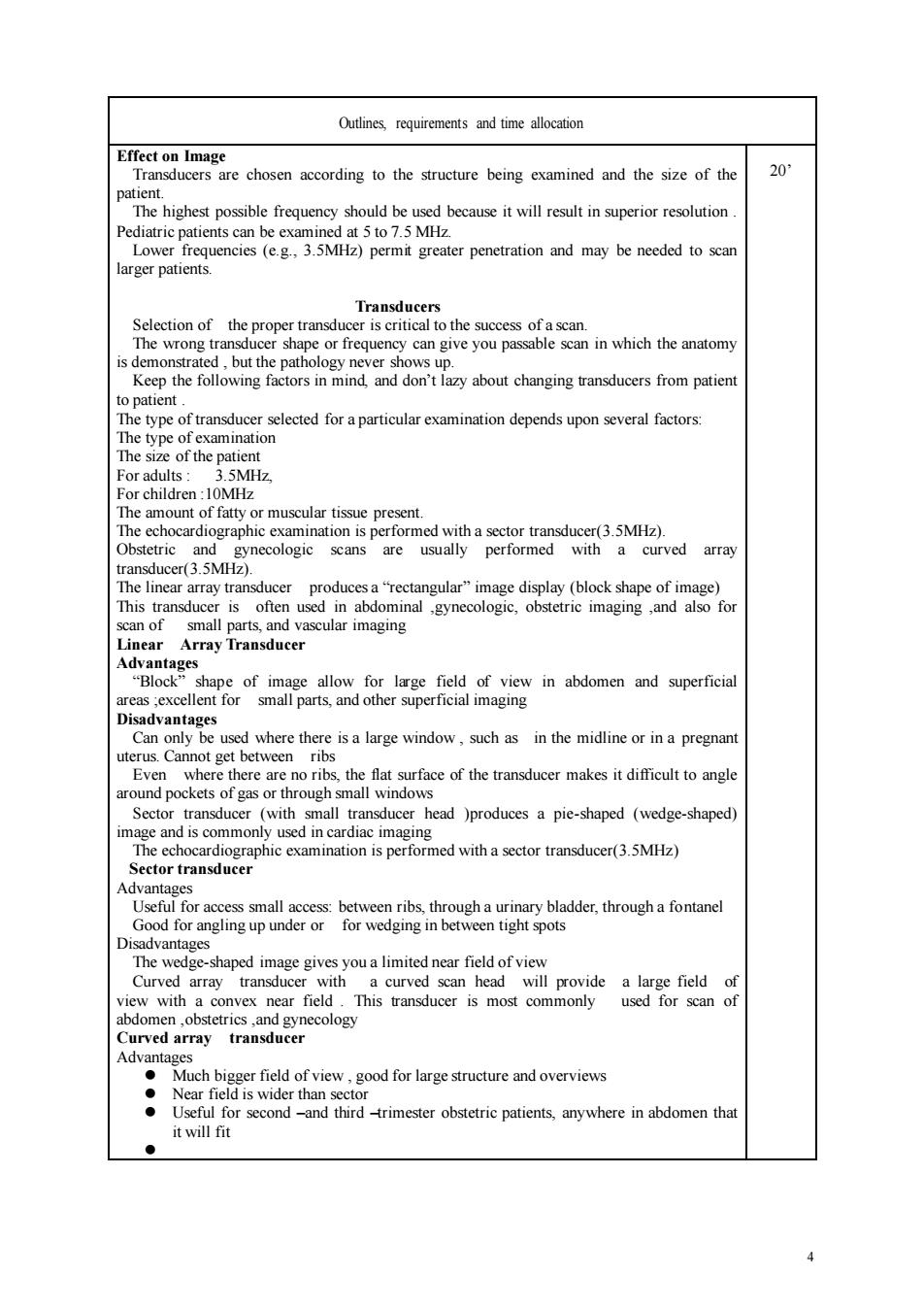
Teaching Plan Name:LU Chuan Academic Year:2012-2013 Term :2 Date:March 18 Period:3-4 Textbook Diagnostic Imaging Content Foundations of 2 Objectives Tomphysics instrumentation,transducers of ultrasound Key points Sound Reflections,Acoustic Impedance,Doppler Effect Por Piezoelectric Effeet Content for lfstudy Interventional ultrasound Teaching equipment multimedia Related knowedge Physics of urasound Teaching methods Heuristic method /discuss Outlinesrequrements and time llo What is Ultrasound? 5 Sound Wave A wave is a propagation energy that moves back and forth or vibrates at a steady rate. Sound wave are mechanical oscillations that are transmitted by particles in a gas liquid,orsolid Wave are generated over a period of time.The time required to produce each cycle depends on the nd is char err to the "om o6时prude of the时m日d e wave is 00000 oscillation/see=1megahertz(1MHz)
1 Teaching Plan Name:LU Chuan Academic Year:2012-2013 Term :2 Date:March 18 Period:3-4 Textbook Diagnostic Imaging Specialty and Stratification 2010MBBSAutumn (international students) Content Foundations of sonography 1 Teaching hours 2 Objectives To master the physics, instrumentation, transducers of ultrasound Key points Sound Reflections, Acoustic Impedance, Doppler Effect Points difficult to understand Piezoelectric Effect Content for self study Interventional ultrasound Teaching equipment multimedia Related knowledge Physics of ultrasound Teaching methods Heuristic method /discuss Outlines, requirements and time allocation What is Ultrasound? U ltrasound refers to sound waves beyond the audible range Generated by an external source, ultrasound is the transmission of high-frequency mechanical vibrations greater than 20 kilohertz (kHz) through a medium. Diagnostic application of ultrasound use frequency of 3.5-10MHz Basics-Physics For Successful Scanning In order to obtain the best image possible, basic fundamentals of ultrasound wave physics must be understood and applied。 Sound Wave A wave is a propagation energy that moves back and forth or vibrates at a steady rate. Sound wave are mechanical oscillations that are transmitted by particles in a gas, liquid, or solid medium. Wave are generated over a period of time. The time required to produce each cycle depends on the frequency of the transducer. This time interval is the period of the wave. As frequencies become higher, the pulse duration decrease, yielding a decrease in the depth of field. Frequen cy Sound is characterized according to its frequency .In ultrasound ,frequency refers to the number of oscillations per second performed by the particles of the medium in which the wave is propagation. 1 oscillation/sec =1 hertz(1Hz) 1000 oscillation/sec = 1 kilohertz (1kHz) 1,000,000 oscillation/sec = 1 megahertz(1MHz) 5’

Outlines requirements and time allocation Wavese soud ie beccn20 to. ound varies by ony a few percent from one is to another. Reflections most frequently received are those that occurred at a perpendicular incidence dime Acoustic Impedance The ultrasound wave is very similar toa light beam in that it may be focused,refracted uic pane betwen the tomedad te'gcwhich hbm hits he in thec nt ion of air-tissue and bone inte no in ound beam is ace. beyond o images cannot scattered as it travels through the body. f the between the various t greater the differer w山光 ture e in density between two structures the str nterface choes defining the boundaries between those two structu son the ultrasound Etectonlmagdgosceghsheeahap网rgca as sier to distinguish from one another than structures of similar acoustic texture(eg kidney and The bright interf es the gallbladder at the diaphragm are due to large differences in liver,is not easy tosee 2
2 Outlines, requirements and time allocation Audible Sound Waves Audible sound waves lie between 20 and 20,000Hz. Velocity of Sound The velocity of sound in a medium is determined by the density and elastic properties of the medium. The velocity of sound differs greatly between air, bone, and soft tissue. On the other hand , the velocity of sound varies by only a few percent from one soft tissue to another. Sound Reflections Reflections most frequently received are those that occurred at a perpendicular incidence. The angel of reflection is equal to the angle of incidence. This occurs at most specular interfaces where the boundary is smooth and where the dimensions of the interface are large than the wavelength When the sound beam is perpendicular to the organ interface, specular echoes are produced When the sound beam is not perpendicular to the organ interface , scatter is seen Acoustic Impedance The ultrasound wave is very similar to a light beam in that it may be focused, refracted, reflection, or scattered at interfaces between different media. At the junction of two media of different acoustic properties, an ultrasound beam may be reflected depending on the difference in acoustic impedance between the two media and the angel at which the beam hits the interface In biologic tissues, with the exception of air-tissue and bone interface, the differences in acoustic impedance are slight so that only a small component of the ultrasound beam is reflected at each interface.Lung and bowl have a detrimental effect on the ultrasound beam, causing poor transmission of sound; therefore structures beyond these two images cannot be imaged because of air interface Bone conducts sound at a much faster speed than soft tissue. Normal transmission of sound through soft tissue travels at 1540 m/sec. Much of the sound beam is absorbed or scattered as it travels through the body, undergoing progressive attenuation. Tissue Acoustic Impedance The strength of the returning echo also depends on the differences in acoustic impedance between the various tissues in the body. Acoustic impedance relates to tissue density:the greater the difference in density between two structures , the stronger the returning interface echoes defining the boundaries between those two structures on the ultrasound image. .( white on the screen) Tissue Acoustic Impedance The greater the difference in density between two structures , the stronger the returning interface echoes defining the boundaries between those two structures on the ultrasound image Effect on Image Structures of differing acoustic impedance (such as the gallbladder and the liver) are much easier to distinguish from one another than structures of similar acoustic texture( e.g., kidney and liver) Tissue Acoustic Impedance The bright interfaces the gallbladder at the diaphragm are due to large differences in acoustic impedance (density) compared with the liver. The kidney ,which is similar to texture to the liver, is not easy to see 10’

Outlinesrequrements and time Piezoelectric Effeet 15 Effect caused by crystals s changing shape when in an electrical field or when Synthetic ceramic erystals have been developed for medical use that can be molded into various shapes and sizes and focused for ultrasound applications.Each ceramic crystal has a sshortpuscdouves foan resulting in an electrical pulse. Doppler and Color Flow Principles The Doppler Effect waves as they are r the ambulance roached and lower as the vehicle deparis comes higher a c9品wen the mnnro n the medical appication of the Doppler principethe sound ave is bounded of amoving ifpioodcel s along the ine of the ultrasound beam (parallel to fow)the Doppler shift is r in the plane of the beam the fall in frequency is qunywill be increased if flow is toward the sound source (transducer)and decreased The frequency of the returning wave can be converted to spectrum and color. Clinical Correlation The Doppler effec tis helpful in blood vessels and determining optima sites for Typically veins have a low-pitch hum,whereas arteries have an alternating pattern with a high-pitch systolic component and low-pitch diastolic component Instrumentation Ultrasound is used to evaluate sof tis anatomic stru thin all areas of the body energy do5nd
3 Outlines, requirements and time allocation Piezoelectric Effect Effect caused by crystals changing shape when in an electrical field or when mechanically stressed , so that a electrical impulse can generate a wave or vice versa Synthetic ceramic crystals have been developed for medical use that can be molded into various shapes and sizes and focused for ultrasound applications. Each ceramic crystal has a resonant frequency that depends on the thickness of the crystal Most diagnostic applications use short ,pulsed ultrasound waves for optimum resolution. As a pulse of ultrasound is emitted , the pulse travels through tissue. When the pulse strikes an interface, part of the energy is reflected. The returning echo is a sound pressure wave that causes a slight mechanical deformation of the ceramic as it impinges on the transducer face, resulting in an electrical pulse. Doppler and Color Flow Principles Doppler physics as it relates to diagnostic ultrasonography concerns the behavior of high-frequency sound waves as they are reflected off moving fluid, usually blood The Doppler Effect The Doppler effect is responsible for the variation in the pitch of the sound wave from an ambulance siren as it moves toward and away from you . The siren pitch becomes higher as the ambulance approached and lower as the vehicle departs The Doppler Principle refers to a change in frequency when the motion of laminar or turbulent flow is detected within a vascular structure. Doppler In the medical application of the Doppler principle the sound wave is bounded off a moving red blood cell. If the cell moves along the line of the ultrasound beam (parallel to flow), the Doppler shift is directly proportional to the velocity of the red cell. If the cell moves away from the transducer in the plane of the beam, the fall in frequency is directly proportional to the velocity and direction of the red blood cell movement. The speed of the moving structure can be calculated from this frequency shift .The returning frequency will be increased if flow is toward the sound source (transducer) and decreased if flow is away from the sound source . The frequency of the returning wave can be converted to spectrum and color. Clinical Correlation The Doppler effect is helpful in localizing blood vessels and determining optimal sites for velocity measurements. Typically veins have a low-pitch hum, whereas arteries have an alternating pattern with a high-pitch systolic component and low-pitch diastolic component. Instrumentation Ultrasound is used to evaluate soft tissue anatomic structures within all areas of the body The patient is examined with a transducer that converts electrical energy into mechanical energy Transducer Frequency Transducers come in many different frequencies –typically 2.5,3.5, 5,7,and 10 MHz. Increasing the frequency improves resolution but decreases penetration. Decreasing the frequency increases penetration but diminishes resolution 15’

Outlines requirements and time allocation Effect on Image 20 The highest possible frequency should be used because it will result in superior resolution arger patients Selection of the proper trasducercteof c The wrong transdu can ive you pasable c in which the anatomy Keep the folowing factors inmind and changing ransducers from patien topatient Thesie of the patient For The amount of fatty or muscular tissue present. cans curved array The linear array trans cer produces a"Tectangular"image display (block shape of image) al ,gynecologic,obstetric imaging ,and also fo Linear Array Transducer Ad bea超vni如ad ncal used where there is a large window,such as in the midline or in a pregnan uterus.Cannot get between ribs Even where Sector transducer (with small transducer head )produces a pie-shaped (wedge-shaped) Advantages small ac Disadvantages The wedge-s provide a large field of iew with a convex near field.This transducer is most commonly used for scan of Much bigger field of viewgod for large structure and overviews it will fit
4 Outlines, requirements and time allocation Effect on Image Transducers are chosen according to the structure being examined and the size of the patient. The highest possible frequency should be used because it will result in superior resolution . Pediatric patients can be examined at 5 to 7.5 MHz. Lower frequencies (e.g., 3.5MHz) permit greater penetration and may be needed to scan larger patients. Transducers Selection of the proper transducer is critical to the success of a scan. The wrong transducer shape or frequency can give you passable scan in which the anatomy is demonstrated , but the pathology never shows up. Keep the following factors in mind, and don’t lazy about changing transducers from patient to patient . The type of transducer selected for a particular examination depends upon several factors: The type of examination The size of the patient For adults : 3.5MHz, For children :10MHz The amount of fatty or muscular tissue present. The echocardiographic examination is performed with a sector transducer(3.5MHz). Obstetric and gynecologic scans are usually performed with a curved array transducer(3.5MHz). The linear array transducer produces a “rectangular” image display (block shape of image) This transducer is often used in abdominal ,gynecologic, obstetric imaging ,and also for scan of small parts, and vascular imaging Linear Array Transducer Advantages “Block” shape of image allow for large field of view in abdomen and superficial areas ;excellent for small parts, and other superficial imaging Disadvantages Can only be used where there is a large window , such as in the midline or in a pregnant uterus. Cannot get between ribs Even where there are no ribs, the flat surface of the transducer makes it difficult to angle around pockets of gas or through small windows Sector transducer (with small transducer head )produces a pie-shaped (wedge-shaped) image and is commonly used in cardiac imaging The echocardiographic examination is performed with a sector transducer(3.5MHz) Sector transducer Advantages Useful for access small access: between ribs, through a urinary bladder, through a fontanel Good for angling up under or for wedging in between tight spots Disadvantages The wedge-shaped image gives you a limited near field of view Curved array transducer with a curved scan head will provide a large field of view with a convex near field . This transducer is most commonly used for scan of abdomen ,obstetrics ,and gynecology Curved array transducer Advantages ⚫ Much bigger field of view , good for large structure and overviews ⚫ Near field is wider than sector ⚫ Useful for second –and third –trimester obstetric patients, anywhere in abdomen that it will fit ⚫ 20’

Outlines requirements and time allocation Disadvantages :装nthy m Small parts(5,7.5,and 1 MHz) Intraoperative probes to small orifices(imaging the brain via bur Special transducers Higher-frequenylnear array probes (7.5-10 MHz)are generally used for small structures uctures in an infant) ast,testes,or structures in an infant) sually at a depth of Endoultrasound Transducer Transvaginal transducer Standard ultrasound ystem are modified so they can be used in a sterile fashion in the Transrectal transducer-special transducer that is introduced into the rectum to evaluate the rectum Display Modes ghtne Doppler Spectra Doppler ntinuous Doppler (CW) Pulsed PW) Color Doppler FlowmainCDFT) Power Dopple
5 Outlines, requirements and time allocation Disadvantages ⚫ Larger transducer face than sector , may not fit in acoustic window ⚫ May get artifacts along sides of image due to poor contact ⚫ Near field is still more limited than linear array , but not by much , so it is becoming the most popular transducer design Special transducers Special transducers have been produced to help view specific areas ⚫ Small parts (5, 7.5, and 10 MHz) ⚫ Rectal transducer ⚫ Biopsy transducer ⚫ Intraoperative probes for access to small orifices( e.g,. imaging the brain via burr holes) or for imaging flat organs( e.g., linear arrays for the liver) ⚫ Endoluminal transducers for accessing vessels , ureter , and the common bile duct Special transducers Biopsy transducer Biopsy under guide of ultrasound Higher-frequency linear array probes (7.5-10 MHz) are generally used for small structures Small part transducer are designed for visualizing the fine detail of superficial structures , usually at a depth of less than 4 cm from the skin surface( e.g., thyroid , carotid arteries breast, testes, or structures in an infant) Small part transducer are designed for visualizing the fine detail of superficial structures , usually at a depth of less than 4 cm from the skin surface( e.g., thyroid , carotid arteries breast, testes, or structures in an infant) Small part transducer are designed for visualizing the fine detail of superficial structures , usually at a depth of less than 4 cm from the skin surface( e.g., thyroid , carotid arteries breast, testes, or structures in an infant) Small part transducer are designed for visualizing the fine detail of superficial structures , usually at a depth of less than 4 cm from the skin surface( e.g., thyroid , carotid arteries breast, testes, or structures in an infant) Endoultrasound Transducer The transducer is placed on the end of rod. This rod is inserted into the rectum, vagina, or esophagus. Even smaller transducers on the end of catheters can be introduced into vessels, the biliary duct ,or the ureter ( transluminal transducers) Transesophageal Echocardiography, TEE Intravascular Ultrasound, IVUS Transvaginal transducer Transvaginal (endovaginal )transducer—a high-frequency probe (10MHz) that is inserted into the vagina to image the uterus, ovaries, and adnexal area. Standard ultrasound system are modified so they can be used in a sterile fashion in the operative room. Special ultrasound probes are used for this purpose. Intraoperative Ultrasonograhy Transrectal transducer-special transducer that is introduced into the rectum to evaluate the prostate, bladder, and rectum Special transducers Display Modes ⚫ A-Mode (Amplitude Modulation). ⚫ B-Mode( Brightness Modulation). ⚫ Doppler Spectral Doppler : Continuous Doppler (CW) Pulsed Doppler (PW) Color Doppler Flow Imaging(CDFI) Power Doppler 15’ 15’